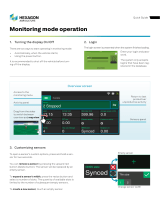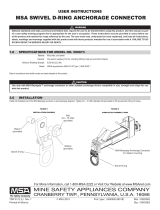
8
3103-1001 Rev. 0
EXHAUST GAS - Sample gas after it passes across the sensor(s).
EXTENDED ANALYSIS TIME - An increase in analysis time triggered by exceeding a preset
level or rate of change.
FLOW RATE - Volume of gas drawn through the sample line per unit of time.
FRESH AIR - Air that has no possibility of containing gas.
HORN ACKNOWLEDGE - Silencing the operation of the horn and local buzzer by depressing the
horn acknowledge button on the overview screen or an optional remote horn acknowledge switch.
HYSTERESIS - A dead band factor introduced into the warning, alarm and trouble functions to
eliminate the relay from responding to small variations in gas level readings in the proximity of its
actuation set point.
LOOK-AHEAD BYPASS FLOW SCHEME - A sample flow scheme that draws on the current
line being sampled and the next line to be sampled.
MULTIGARD 5000 DUAL SYSTEM – An MSA gas sampling system that uses one MultiGard
5000 controller (PLC) and one MultiGard 5000 operator interface (HMI) to operate two otherwise
independent flow systems.
NORMALLY DE-ENERGIZED / NON FAIL-SAFE - A relay that is open when de-energized,
and closed when energized due to a warning, alarm, or fault. This style relay will NOT alert the user
to a loss of power or a failure in the system wiring.
NORMALLY ENERGIZED / FAIL-SAFE - A relay that is open when energized, and closed
when de-energized due to a warning, alarm, fault, or loss of power. This style relay will alert the
operator when there is a loss of power, or a failure in the system wiring.
NORMAL OPERATING STATE - The absence of any alarming indication.
POINT BYPASS - Removing a point/line number from the sampling sequence.
PURGING (FLOW SYSTEM) -The process of flushing the flow system of residual gas after an
auto standardization has occurred or after an indication of possible sensor saturation on a
combustible sensor.
RELATIVE HUMIDITY – The percentage of total water saturation in the air for a given
temperature.
SAMPLE POINT - The location or area from which a gas sample is drawn. Up to 32 areas
(depending on system configuration), sequentially numbered, can be monitored. In dual systems,
System A and System B may each have up to 16 points (depending on system configuration),
sequentially numbered.
























